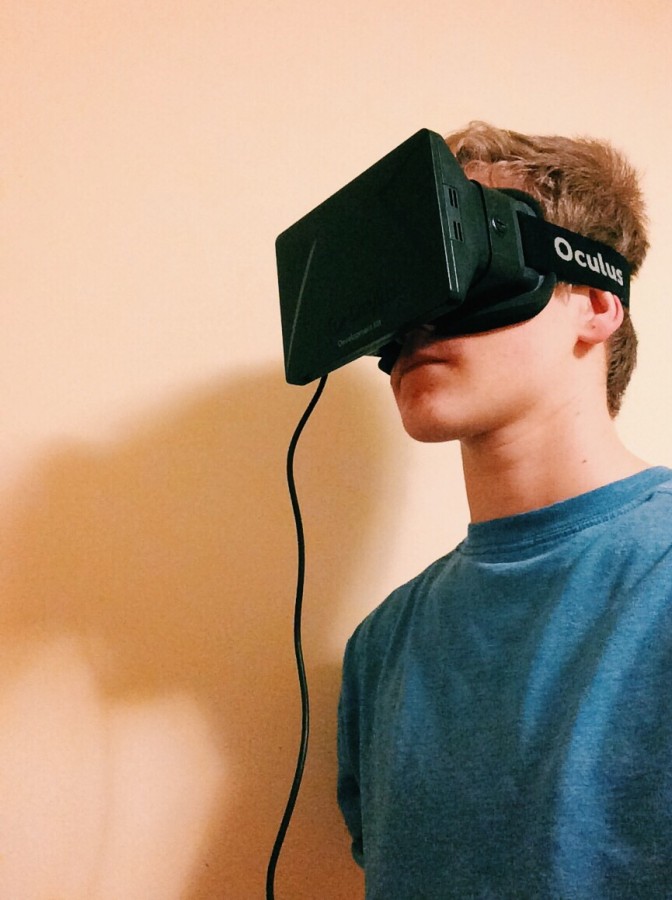VR Makes Real Learning Virtually Impossible
Photo Courtesy of Marco Gramkee
The new Oculus Rift is quickly becoming a very popular device.
February 25, 2016
A decade from now, students won’t learn by interacting with their peers and teachers, or by experiencing their physical world with their senses. Instead, they’ll learn by putting on a pair of goggles and sitting completely still.
Four representatives from the Google Expeditions team visited CHS on Dec. 17 to allow students to take a virtual field trip using the company’s cardboard virtual reality (VR) viewer.
While the Google Expeditions program intends to enhance a student’s educational experience, it may actually end up destroying a student’s ability to interact with other people and the physical world.
I had the opportunity to go on a virtual expedition myself. This past summer, VR technologies such as the Oculus Rift and Google Expeditions were just being released to the press as a possible product for consumer sale. Using a pair of heavy goggles and headphones, I was transported through time to a city in Belgium 700 years ago, and I could use 360 degree vision to see the animation all around me.
After overcoming the initial awe of being inside a real animation, it was hard to think that what was around me really wasn’t the world I know and love. It frightened me to think that this type of technological isolation could be how a student like me, only a decade or so into the future, has history class.
According to the Family Education Network, studies have confirmed that one of the top methods for children to learn in school is through a tangible experience in which they can collaborate, or kinesthetic learning. Kids learn best by doing, not watching.
Because students in a virtual reality setting are not in a physical, tangible world, they will have a harder time learning the material given to them through only their sense of vision. Also, without person-to-person collaboration in schools, children will become more and more isolated from their peers and more immersed in technology, causing them to lose crucial social skills necessary for their daily lives.
According to Venture Beat magazine, beyond eliminating social and collaborative efforts, VR technology could have numerous effects on eyesight. In children, whose eyes are still developing, it can cause a condition in which one eye turns outward, or a “lazy eye”.
VR viewers isolate students in the outside world and affect a their physical ability to see their real, physical surroundings.
According to a UK Virtual Reality blog, VR goggles can also cause motion sickness, or “cybersickness.” Spending a long period of time in a virtual environment can cause shifts in perception and balance. Some people are affected after only 30 minutes of using the goggles.
A new program called MakerSpace may offer an alternative to Google Expeditions. It would actually make use of a students’ tangible world and allow them to interact with others.
According to Educause, a nonprofit dedicated to promoting the intelligent use of information in education, a MakerSpace is a physical location where people gather to share resources and knowledge, as well as work on projects and network.
It has emerged as a powerful learning force, allowing hands-on learning through the use of a 3-D printer. MakerSpaces have been put into college campuses like Tufts University to encourage joint project collaboration.
To be clear, innovation in technology isn’t bad. Innovation in technology that limits human interaction and hands-on learning is.
Programs like MakerSpace would be the perfect alternative to VR because they are still visual technology in 3D, but allow people to collaborate in the actual world.
However, VR technology would work well for journalism, psychology and global issues as it allows for people to truly see in 3D the hardships that take place around the world. For example, the New York Times already offers a free, 3D video on their website that allows the viewer to be immersed in the grievous scene at the candlelight vigils in Paris after the Nov. 13 attacks.
While Virtual Reality technology may have wonderful applications in other areas such as journalism, it has absolutely no place in education. If a person’s ability to make person-to-person connections and use their five senses in their physical world is taken from them, they may lose their ability to learn from their surroundings in the way that humans have always done, by doing.


